Shuai Yang
Towards Efficient Agents: A Co-Design of Inference Architecture and System
Dec 20, 2025Abstract:The rapid development of large language model (LLM)-based agents has unlocked new possibilities for autonomous multi-turn reasoning and tool-augmented decision-making. However, their real-world deployment is hindered by severe inefficiencies that arise not from isolated model inference, but from the systemic latency accumulated across reasoning loops, context growth, and heterogeneous tool interactions. This paper presents AgentInfer, a unified framework for end-to-end agent acceleration that bridges inference optimization and architectural design. We decompose the problem into four synergistic components: AgentCollab, a hierarchical dual-model reasoning framework that balances large- and small-model usage through dynamic role assignment; AgentSched, a cache-aware hybrid scheduler that minimizes latency under heterogeneous request patterns; AgentSAM, a suffix-automaton-based speculative decoding method that reuses multi-session semantic memory to achieve low-overhead inference acceleration; and AgentCompress, a semantic compression mechanism that asynchronously distills and reorganizes agent memory without disrupting ongoing reasoning. Together, these modules form a Self-Evolution Engine capable of sustaining efficiency and cognitive stability throughout long-horizon reasoning tasks. Experiments on the BrowseComp-zh and DeepDiver benchmarks demonstrate that through the synergistic collaboration of these methods, AgentInfer reduces ineffective token consumption by over 50%, achieving an overall 1.8-2.5 times speedup with preserved accuracy. These results underscore that optimizing for agentic task completion-rather than merely per-token throughput-is the key to building scalable, efficient, and self-improving intelligent systems.
Trainable Log-linear Sparse Attention for Efficient Diffusion Transformers
Dec 18, 2025Abstract:Diffusion Transformers (DiTs) set the state of the art in visual generation, yet their quadratic self-attention cost fundamentally limits scaling to long token sequences. Recent Top-K sparse attention approaches reduce the computation of DiTs by compressing tokens into block-wise representation and selecting a small set of relevant key blocks, but still suffer from (i) quadratic selection cost on compressed tokens and (ii) increasing K required to maintain model quality as sequences grow. We identify that their inefficiency is due to the single-level design, as a single coarse level is insufficient to represent the global structure. In this paper, we introduce Log-linear Sparse Attention (LLSA), a trainable sparse attention mechanism for extremely long token sequences that reduces both selection and attention costs from quadratic to log-linear complexity by utilizing a hierarchical structure. LLSA performs hierarchical Top-K selection, progressively adopting sparse Top-K selection with the indices found at the previous level, and introduces a Hierarchical KV Enrichment mechanism that preserves global context while using fewer tokens of different granularity during attention computation. To support efficient training, we develop a high-performance GPU implementation that uses only sparse indices for both the forward and backward passes, eliminating the need for dense attention masks. We evaluate LLSA on high-resolution pixel-space image generation without using patchification and VAE encoding. LLSA accelerates attention inference by 28.27x and DiT training by 6.09x on 256x256 pixel token sequences, while maintaining generation quality. The results demonstrate that LLSA offers a promising direction for training long-sequence DiTs efficiently. Code is available at: https://github.com/SingleZombie/LLSA
MemFlow: Flowing Adaptive Memory for Consistent and Efficient Long Video Narratives
Dec 16, 2025Abstract:The core challenge for streaming video generation is maintaining the content consistency in long context, which poses high requirement for the memory design. Most existing solutions maintain the memory by compressing historical frames with predefined strategies. However, different to-generate video chunks should refer to different historical cues, which is hard to satisfy with fixed strategies. In this work, we propose MemFlow to address this problem. Specifically, before generating the coming chunk, we dynamically update the memory bank by retrieving the most relevant historical frames with the text prompt of this chunk. This design enables narrative coherence even if new event happens or scenario switches in future frames. In addition, during generation, we only activate the most relevant tokens in the memory bank for each query in the attention layers, which effectively guarantees the generation efficiency. In this way, MemFlow achieves outstanding long-context consistency with negligible computation burden (7.9% speed reduction compared with the memory-free baseline) and keeps the compatibility with any streaming video generation model with KV cache.
LongLive: Real-time Interactive Long Video Generation
Sep 26, 2025Abstract:We present LongLive, a frame-level autoregressive (AR) framework for real-time and interactive long video generation. Long video generation presents challenges in both efficiency and quality. Diffusion and Diffusion-Forcing models can produce high-quality videos but suffer from low efficiency due to bidirectional attention. Causal attention AR models support KV caching for faster inference, but often degrade in quality on long videos due to memory challenges during long-video training. In addition, beyond static prompt-based generation, interactive capabilities, such as streaming prompt inputs, are critical for dynamic content creation, enabling users to guide narratives in real time. This interactive requirement significantly increases complexity, especially in ensuring visual consistency and semantic coherence during prompt transitions. To address these challenges, LongLive adopts a causal, frame-level AR design that integrates a KV-recache mechanism that refreshes cached states with new prompts for smooth, adherent switches; streaming long tuning to enable long video training and to align training and inference (train-long-test-long); and short window attention paired with a frame-level attention sink, shorten as frame sink, preserving long-range consistency while enabling faster generation. With these key designs, LongLive fine-tunes a 1.3B-parameter short-clip model to minute-long generation in just 32 GPU-days. At inference, LongLive sustains 20.7 FPS on a single NVIDIA H100, achieves strong performance on VBench in both short and long videos. LongLive supports up to 240-second videos on a single H100 GPU. LongLive further supports INT8-quantized inference with only marginal quality loss.
LINR Bridge: Vector Graphic Animation via Neural Implicits and Video Diffusion Priors
Sep 09, 2025Abstract:Vector graphics, known for their scalability and user-friendliness, provide a unique approach to visual content compared to traditional pixel-based images. Animation of these graphics, driven by the motion of their elements, offers enhanced comprehensibility and controllability but often requires substantial manual effort. To automate this process, we propose a novel method that integrates implicit neural representations with text-to-video diffusion models for vector graphic animation. Our approach employs layered implicit neural representations to reconstruct vector graphics, preserving their inherent properties such as infinite resolution and precise color and shape constraints, which effectively bridges the large domain gap between vector graphics and diffusion models. The neural representations are then optimized using video score distillation sampling, which leverages motion priors from pretrained text-to-video diffusion models. Finally, the vector graphics are warped to match the representations resulting in smooth animation. Experimental results validate the effectiveness of our method in generating vivid and natural vector graphic animations, demonstrating significant improvement over existing techniques that suffer from limitations in flexibility and animation quality.
ANYPORTAL: Zero-Shot Consistent Video Background Replacement
Sep 09, 2025



Abstract:Despite the rapid advancements in video generation technology, creating high-quality videos that precisely align with user intentions remains a significant challenge. Existing methods often fail to achieve fine-grained control over video details, limiting their practical applicability. We introduce ANYPORTAL, a novel zero-shot framework for video background replacement that leverages pre-trained diffusion models. Our framework collaboratively integrates the temporal prior of video diffusion models with the relighting capabilities of image diffusion models in a zero-shot setting. To address the critical challenge of foreground consistency, we propose a Refinement Projection Algorithm, which enables pixel-level detail manipulation to ensure precise foreground preservation. ANYPORTAL is training-free and overcomes the challenges of achieving foreground consistency and temporally coherent relighting. Experimental results demonstrate that ANYPORTAL achieves high-quality results on consumer-grade GPUs, offering a practical and efficient solution for video content creation and editing.
STream3R: Scalable Sequential 3D Reconstruction with Causal Transformer
Aug 14, 2025Abstract:We present STream3R, a novel approach to 3D reconstruction that reformulates pointmap prediction as a decoder-only Transformer problem. Existing state-of-the-art methods for multi-view reconstruction either depend on expensive global optimization or rely on simplistic memory mechanisms that scale poorly with sequence length. In contrast, STream3R introduces an streaming framework that processes image sequences efficiently using causal attention, inspired by advances in modern language modeling. By learning geometric priors from large-scale 3D datasets, STream3R generalizes well to diverse and challenging scenarios, including dynamic scenes where traditional methods often fail. Extensive experiments show that our method consistently outperforms prior work across both static and dynamic scene benchmarks. Moreover, STream3R is inherently compatible with LLM-style training infrastructure, enabling efficient large-scale pretraining and fine-tuning for various downstream 3D tasks. Our results underscore the potential of causal Transformer models for online 3D perception, paving the way for real-time 3D understanding in streaming environments. More details can be found in our project page: https://nirvanalan.github.io/projects/stream3r.
InstructVLA: Vision-Language-Action Instruction Tuning from Understanding to Manipulation
Jul 23, 2025Abstract:To operate effectively in the real world, robots must integrate multimodal reasoning with precise action generation. However, existing vision-language-action (VLA) models often sacrifice one for the other, narrow their abilities to task-specific manipulation data, and suffer catastrophic forgetting of pre-trained vision-language capabilities. To bridge this gap, we introduce InstructVLA, an end-to-end VLA model that preserves the flexible reasoning of large vision-language models (VLMs) while delivering leading manipulation performance. InstructVLA introduces a novel training paradigm, Vision-Language-Action Instruction Tuning (VLA-IT), which employs multimodal training with mixture-of-experts adaptation to jointly optimize textual reasoning and action generation on both standard VLM corpora and a curated 650K-sample VLA-IT dataset. On in-domain SimplerEnv tasks, InstructVLA achieves 30.5% improvement over SpatialVLA. To evaluate generalization, we introduce SimplerEnv-Instruct, an 80-task benchmark requiring closed-loop control and high-level instruction understanding, where it outperforms a fine-tuned OpenVLA by 92% and an action expert aided by GPT-4o by 29%. Additionally, InstructVLA surpasses baseline VLMs on multimodal tasks and exhibits inference-time scaling by leveraging textual reasoning to boost manipulation performance in both simulated and real-world settings. These results demonstrate InstructVLA's potential for bridging intuitive and steerable human-robot interaction with efficient policy learning.
CronusVLA: Transferring Latent Motion Across Time for Multi-Frame Prediction in Manipulation
Jun 24, 2025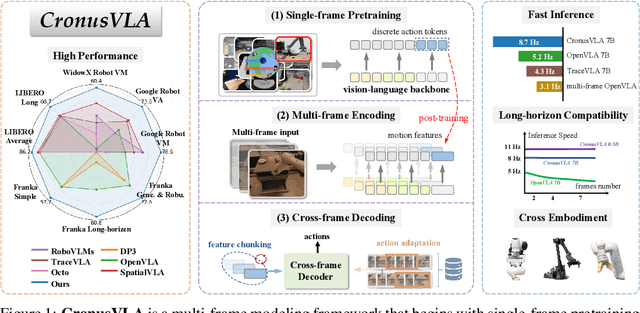
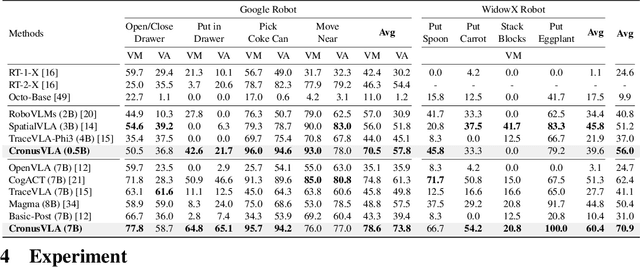
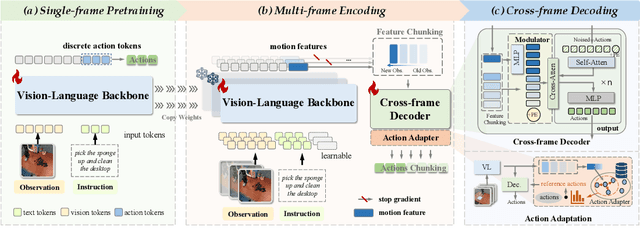
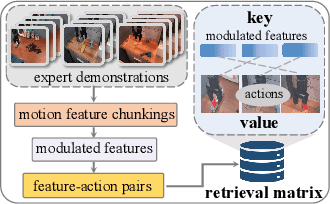
Abstract:Recent vision-language-action (VLA) models built on pretrained vision-language models (VLMs) have demonstrated strong generalization across manipulation tasks. However, they remain constrained by a single-frame observation paradigm and cannot fully benefit from the motion information offered by aggregated multi-frame historical observations, as the large vision-language backbone introduces substantial computational cost and inference latency. We propose CronusVLA, a unified framework that extends single-frame VLA models to the multi-frame paradigm through an efficient post-training stage. CronusVLA comprises three key components: (1) single-frame pretraining on large-scale embodied datasets with autoregressive action tokens prediction, which establishes an embodied vision-language foundation; (2) multi-frame encoding, adapting the prediction of vision-language backbones from discrete action tokens to motion features during post-training, and aggregating motion features from historical frames into a feature chunking; (3) cross-frame decoding, which maps the feature chunking to accurate actions via a shared decoder with cross-attention. By reducing redundant token computation and caching past motion features, CronusVLA achieves efficient inference. As an application of motion features, we further propose an action adaptation mechanism based on feature-action retrieval to improve model performance during finetuning. CronusVLA achieves state-of-the-art performance on SimplerEnv with 70.9% success rate, and 12.7% improvement over OpenVLA on LIBERO. Real-world Franka experiments also show the strong performance and robustness.
GENMANIP: LLM-driven Simulation for Generalizable Instruction-Following Manipulation
Jun 12, 2025

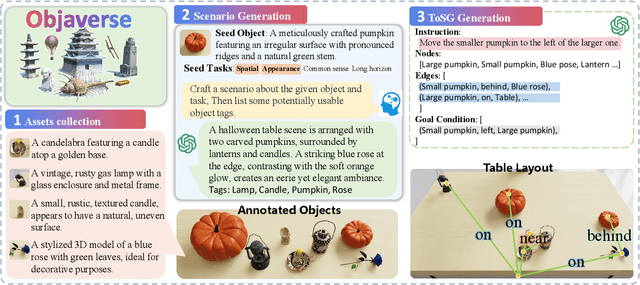

Abstract:Robotic manipulation in real-world settings remains challenging, especially regarding robust generalization. Existing simulation platforms lack sufficient support for exploring how policies adapt to varied instructions and scenarios. Thus, they lag behind the growing interest in instruction-following foundation models like LLMs, whose adaptability is crucial yet remains underexplored in fair comparisons. To bridge this gap, we introduce GenManip, a realistic tabletop simulation platform tailored for policy generalization studies. It features an automatic pipeline via LLM-driven task-oriented scene graph to synthesize large-scale, diverse tasks using 10K annotated 3D object assets. To systematically assess generalization, we present GenManip-Bench, a benchmark of 200 scenarios refined via human-in-the-loop corrections. We evaluate two policy types: (1) modular manipulation systems integrating foundation models for perception, reasoning, and planning, and (2) end-to-end policies trained through scalable data collection. Results show that while data scaling benefits end-to-end methods, modular systems enhanced with foundation models generalize more effectively across diverse scenarios. We anticipate this platform to facilitate critical insights for advancing policy generalization in realistic conditions. Project Page: https://genmanip.axi404.top/.
 Add to Chrome
Add to Chrome Add to Firefox
Add to Firefox Add to Edge
Add to Edge